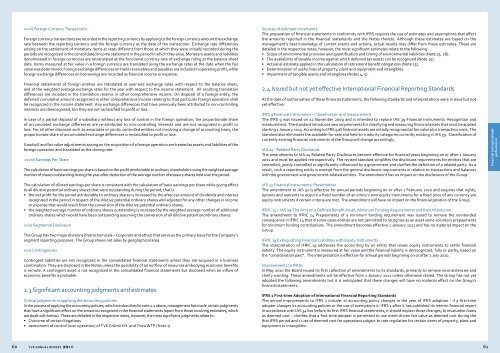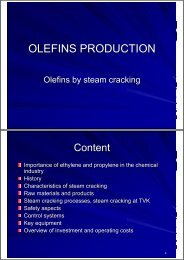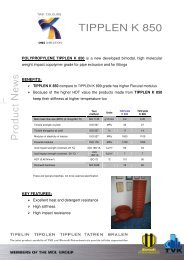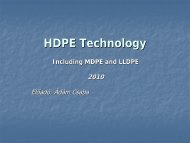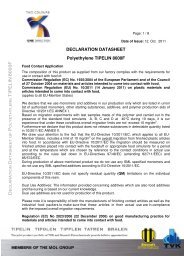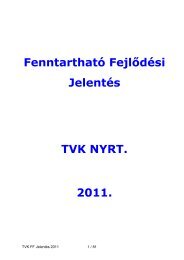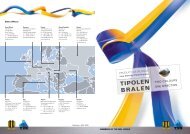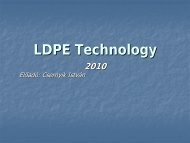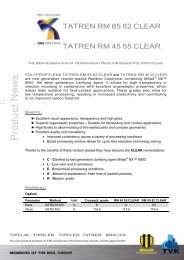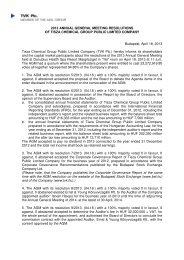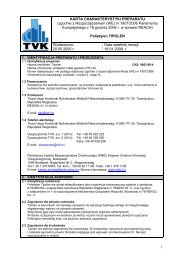TVK Annual Report 2010 (pdf, 2.5 MB)
TVK Annual Report 2010 (pdf, 2.5 MB)
TVK Annual Report 2010 (pdf, 2.5 MB)
Create successful ePaper yourself
Turn your PDF publications into a flip-book with our unique Google optimized e-Paper software.
xxvii) Foreign Currency Transactions<br />
Foreign currency transactions are recorded in the reporting currency by applying to the foreign currency amount the exchange<br />
rate between the reporting currency and the foreign currency at the date of the transaction. Exchange rate differences<br />
arising on the settlement of monetary items at rates different from those at which they were initially recorded during the<br />
periods are recognized in the consolidated income statement in the period in which they arise. Monetary assets and liabilities<br />
denominated in foreign currencies are retranslated at the functional currency rate of exchange ruling at the balance sheet<br />
date. Items measured at fair value in a foreign currency are translated using the exchange rates at the date when the fair<br />
value was determined. Foreign exchange differences on trade receivables and payables are included in operating profit, while<br />
foreign exchange differences on borrowings are recorded as financial income or expense.<br />
Sources of estimate uncertainty<br />
The preparation of financial statements in conformity with IFRS requires the use of estimates and assumptions that affect<br />
the amounts reported in the financial statements and the Notes thereto. Although these estimates are based on the<br />
management’s best knowledge of current events and actions, actual results may differ from those estimates. These are<br />
detailed in the respective notes, however, the most significant estimates relate to the following:<br />
• Scope of environmental provision and quantification and timing of environmental liabilities (Note 15, 28).<br />
• The availability of taxable income against which deferred tax assets can be recognized (Note 25).<br />
• Actuarial estimate applied in the calculation of retirement benefit obligations (Note 15).<br />
• Determination of useful lives of property, plant and equipment and intangibles.<br />
• Impairment of tangible assets and intangibles (Notes 4, 5).<br />
Financial statements of foreign entities are translated at year-end exchange rates with respect to the balance sheet,<br />
and at the weighted average exchange rates for the year with respect to the income statement. All resulting translation<br />
differences are included in the translation reserve in other comprehensive income. On disposal of a foreign entity, the<br />
deferred cumulative amount recognized in other comprehensive income relating to that particular foreign operation shall<br />
be recognized in the income statement. Any exchange differences that have previously been attributed to non-controlling<br />
interests are derecognised, but they are not reclassified to profit or loss.<br />
In case of a partial disposal of a subsidiary without any loss of control in the foreign operation, the proportionate share<br />
of accumulated exchange differences are re-attributed to non-controlling interests and are not recognised in profit or<br />
loss. For all other disposals such as associates or jointly controlled entities not involving a change of accounting basis, the<br />
proportionate share of accumulated exchange differences is reclassified to profit or loss.<br />
Goodwill and fair value adjustments arising on the acquisition of a foreign operation are treated as assets and liabilities of the<br />
foreign operation and translated at the closing rate.<br />
xxviii) Earnings Per Share<br />
The calculation of basic earnings per share is based on the profit attributable to ordinary shareholders using the weighted average<br />
number of shares outstanding during the year after deduction of the average number of treasury shares held over the period.<br />
2.4 Issued but not yet effective International Financial <strong>Report</strong>ing Standards<br />
At the date of authorisation of these financial statements, the following standards and interpretations were in issue but not<br />
yet effective:<br />
IFRS 9 Financial Instruments – Classification and measurement<br />
The IFRS 9 was issued on 12 November 2009 and is intended to replace IAS 39 Financial Instruments: Recognition and<br />
measurement. The standard introduces new requirements for classifying and measuring financial assets that must be applied<br />
starting 1 January 2013. According to IFRS 9 all financial assets are initially recognised at fair value plus transaction costs. The<br />
standard also eliminates the available-for-sale and held-to-maturity categories currently existing in IAS 39. Classification of<br />
currently existing financial instruments of the Group will change accordingly.<br />
IAS 24 - Related Party Disclosure<br />
The amendments to IAS 24 Related Party Disclosures become effective for financial years beginning on or after 1 January<br />
2011 and must be applied retrospectively. The revised standard simplifies the disclosure requirements for entities that are<br />
controlled, jointly controlled or significantly influenced by a government and clarifies the definition of a related party. As a<br />
result, such a reporting entity is exempt from the general disclosure requirements in relation to transactions and balances<br />
with the government and government-related entities. The amendment has no impact on the disclosures of the Group.<br />
Financial and operational<br />
performance<br />
The calculation of diluted earnings per share is consistent with the calculation of basic earnings per share while giving effect<br />
to all dilutive potential ordinary shares that were outstanding during the period, that is:<br />
• the net profit for the period attributable to ordinary shares is increased by the after-tax amount of dividends and interest<br />
recognised in the period in respect of the dilutive potential ordinary shares and adjusted for any other changes in income<br />
or expense that would result from the conversion of the dilutive potential ordinary shares.<br />
• the weighted average number of ordinary shares outstanding is increased by the weighted average number of additional<br />
ordinary shares which would have been outstanding assuming the conversion of all dilutive potential ordinary shares.<br />
xxix) Segmental Disclosure<br />
The Group has two major divisions (Petrochemicals – Corporate and other) that serve as the primary basis for the Company’s<br />
segment reporting purposes. The Group shows net sales by geographical area.<br />
xxx) Contingencies<br />
Contingent liabilities are not recognized in the consolidated financial statements unless they are acquired in a business<br />
combination. They are disclosed in the Notes unless the possibility of an outflow of resources embodying economic benefits<br />
is remote. A contingent asset is not recognized in the consolidated financial statements but disclosed when an inflow of<br />
economic benefits is probable.<br />
2.3 Significant accounting judgments and estimates<br />
Critical judgments in applying the accounting policies<br />
In the process of applying the accounting policies, which are described in note 2.2 above, management has made certain judgments<br />
that have a significant effect on the amounts recognized in the financial statements (apart from those involving estimates, which<br />
are dealt with below). These are detailed in the respective notes, however, the most significant judgments relate to:<br />
• Outcome of certain litigations<br />
• assessment of control (over operation) of <strong>TVK</strong> Erőmű Kft. and Tisza WTP (Note 1)<br />
IAS 32 Financial Instruments: Presentation<br />
The amendment to IAS 32 is effective for annual periods beginning on or after 1 February <strong>2010</strong> and requires that rights,<br />
options and warrants to acquire a fixed number of an entity’s own equity instruments for a fixed price of any currency are<br />
equity instruments if certain criteria are met. The amendment will have no impact on the financial position of the Group.<br />
IFRIC 14 – IAS 19-The limit on a Defined Benefit Asset, Minimum Funding Requirements and their Interaction<br />
The amendment to IFRIC 14 Prepayments of a minimum funding requirement was issued to remove the unintended<br />
consequence in IFRIC 14 that in some cases entities are not permitted to recognize as an asset some voluntary prepayments<br />
for minimum funding contributions. The amendment becomes effective 1 January 2011 and has no material impact on the<br />
Group.<br />
IFRIC 19 Extinguishing Financial Liabilities with Equity Instruments<br />
The interpretation of IFRIC 19 addresses the accounting by an entity that issues equity instruments to settle financial<br />
liability. The equity instrument is measured at fair value and the financial liability is derecognized, fully or partly, based on<br />
the “consideration paid”. The interpretation is effective for annual periods beginning on or after 1 July <strong>2010</strong>.<br />
Improvements to IFRSs<br />
In May <strong>2010</strong> the Board issued its first collection of amendments to its standards, primarily to remove inconsistencies and<br />
clarify wording. These amendments will be effective from 1 January 2011 unless otherwise stated. The Group has not yet<br />
adopted the following amendments but it is anticipated that these changes will have no material effect on the Group’s<br />
financial statements.<br />
IFRS 1 First-time Adoption of International Financial <strong>Report</strong>ing Standards<br />
The annual improvements to IFRS 1 include: a) accounting policy changes in the year of IFRS adoption - if a first-time<br />
adopter changes its accounting policies or the use of exemptions in IFRS 1 after it has published its interim financial report<br />
in accordance with IAS 34 but before its first IFRS financial statements, it should explain those changes; b) revaluation basis<br />
as deemed cost – clarifies that a first-time adopter is permitted to use event-driven fair value as deemed cost during the<br />
first IFRS period and c) use of deemed cost for operations subject to rate regulation for certain items of property, plant and<br />
equipment or intangibles.<br />
60 <strong>TVK</strong> <strong>Annual</strong> <strong>Report</strong> <strong>2010</strong><br />
61


